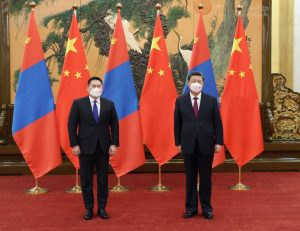Mongolian Prime Minister Oyun-Erdene Luvsannamsrai and his delegation recently concluded a five-day working visit to China. During his visit, Oyun-Erdene attended the Opening Ceremony of the 2022 Beijing Winter Olympics and met with Chinese President Xi Jinping and other high-level officials, including Premier Li Keqiang. In addition, the two sides reached a significant breakthrough on railroad and infrastructure projects that have been stalled for more than a decade.
On February 7, Xi received the Mongolian prime minister at the Great Hall of the People in Beijing. During the high-level meeting, Xi expressed China’s goal for cooperation with Mongolia, with an emphasis on infrastructure and development-based projects.
According to China’s Foreign Ministry, “Xi Jinping stressed that both sides should respect each other’s independence, sovereignty, and territorial integrity, respect each other’s choice of development path, accommodate each other’s core interests, and firmly steer the proper development of China-Mongolia relations.”
In a joint statement, Mongolia and China reiterated respect for each other’s independence and territorial integrity, as well as the principle of non-interference in domestic politics. They also pledged to engage in cooperation and assistance as comprehensive strategic partners. Mongolia hopes to accelerate economic activities, including trade, major infrastructure projects, railroad, and development-based cooperation. According to the foreign minister of Mongolia, Battsetseg Batmunkh, Oyun-Erdene and Xi held a “fruitful high-level dialogue.”
During the exchanges, the two sides discussed plans for railroads at the Gashuunsukhait-Gantsmod and Shiveekhuren-Sekhee border crossings. This has been a long-standing priority for Mongolia, particularly the construction of a railway at Gashuunsukhait-Gantsmod – the port handles more than 50 percent of Mongolia’s copper and coking coal exports. Oyun-Erdene had urged Xi to “pay special attention” to railway construction at Gashuunsukhait-Gantsmod during their meeting.
In October 2021, Mongolia’s road and transportation development minister, Khaltar Luvsan, explained the necessary steps that needs to be taken by both Mongolia and China in order to finalize the railroad border crossing points. “Mongolia and China need to address and finalize two issues regarding the Gashuunsukhait-Gantsmod port. First, we need to agree on where the railroad border crossing meets,” Khaltar said. “Second, we need to follow the aegis of the international freight protocols, which means Mongolian coals will be transferred to the Chinese trains in Gantsmod.”
During the February meetings, Mongolia and China finalized these two protracted issues in a breakthrough – particularly for the Mongolian side.
The Gashuunsukhait-Gantsmod border crossing has been a contentious topic for Mongolian policymakers for years. Although different parties and ministries have agreed on the economic importance of the railroad, they disagreed on many important technical aspects such as the railroad gauge, allocation of investment, and the environmental and geological impacts that come with such a significant megaproject. The financial question was one of the major hurdles as well. The China-proposed railroad project is more costly than what the Mongolians envisioned.
Finalizing agreements on the border crossing points does not mean these dynamics have disappeared or been overlooked. In particular, the proposed railroad may go through a nationally protected heritage site. Remaining issues need to be fully addressed and solved by the Mongolian side.
From a geopolitical standpoint, Mongolia’s landlocked position poses a constant struggle for administrations to push their economic agenda. Mongolia’s foreign policy, especially relations with its two neighbors – Russia and China – must construct tangible economic benefits. Establishing strong relations with China and Russia, gives Mongolia access to maritime routes and the ability to trade with and export to third-neighbor countries.
The recent China-Mongolia bilateral agreements illustrate Mongolia’s economic goals. In China’s case, the objectives entail more geopolitical nuance.
China has a growing need to strengthen its diplomatic relations in general as it continues to compete strategically with the United States. Beijing’s strategy amid the geopolitical competition is to bolster economic ties with countries around the world, with the expectation that will lead to increased political support. It is strategically crucial, then, for Beijing to accelerate bilateral agreements, negotiations, economic, and trade deals.
On the energy front in particular, China has more immediate needs as well. After experiencing months of energy shortage, China’s short- and long-term goals are to secure energy sources for state-owned factories and private enterprises alike. The Chinese government has an opportunity to ensure increased energy supply from Russia and Mongolia. Pushing forward plans to increase connectivity with Mongolia will help in that regard. Mongolia’s proximity and high-quality coal might be exactly what China needs – and increased trade will work to Mongolia’s economic advantage.
The successful working visit of Oyun-Erdene promised an elevated comprehensive strategic partnership between the two governments. As Mongolia continues to implement its long-term development strategy, Vision 2050, activating economic strategic partnership with China will incentivize other partners to step up their economic game with Mongolia.
































